History of Circumcision
from the dawn of the human race
for Circumcision in Art click here.
Before even considering archaeological or iconographic evidence, there is one compelling reason to believe that the practice of circumcision is of vast antiquity, and that is its global distribution. Homo sapiens evolved in Africa about 200,000 years ago and spread throughout the world from about 125,000 years ago. In this our ancestors were following in the footsteps of many earlier hominid species. Expansion westwards from Asia Minor into Europe was initially hindered by the well-established population of light-skinned Neanderthals, so they turned eastwards, reaching India, southeast Asia and China around 75,000 years ago. [1]. The map (below) shows them arriving in Australia 50,000 years ago, but research keeps pushing that date back, and it now seems that modern humans could have been there between 60,000 and 70,000 years ago.
On the other hand, Home sapiens arrived in Europe about 40,000 years ago, where a limited amount of cross-breeding with Neanderthals gave modern Europeans their pale skins - a great advantage in northern latitudes where a dark skin could lead to vitamin D deficiency. Homo sapiens didn't reach North America until 15,000 years ago, and it took them at least another 3,000 years to get down to South America. The most recent 'developed' country to be settled by humans was New Zealand, just 1,500 years ago. (Again, the map is a little misleading here - it seems to show that New Zealand was settled by Melanesians, but in fact the settlers were Polynesian.)
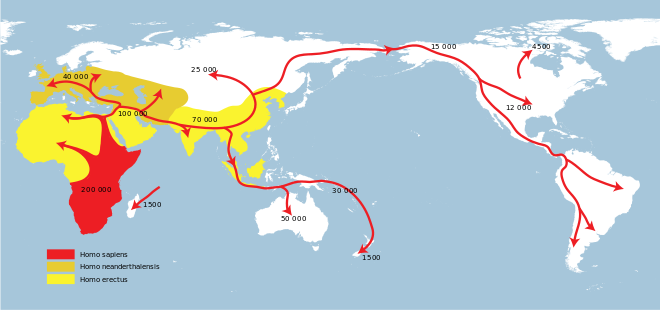 Human migrations out of Africa. [2]
Human migrations out of Africa. [2]
Circumcision is widespread in Africa, and it could therefore have been the custom of the earliest modern humans - and even some of their predecessors. Various considerations suggest this, particularly since our closest living relatives, the great apes, do not have foreskins anything like human ones [3].
Looking at what we know of the ancient world, circumcision is customary among the Australian Aborigines (settled ~ 60,000 years ago, and with very little contact to the outer world since then). It was historically common in north Africa and the Middle East (settled over 100,000 years ago) and it appears from cave art to have been common in Europe before the last Ice Age (see below). In east Asia it was the custom of the Mongoliians, the Ainq (original inhabitants of Japan) [4], the Filipinos, and their close relatives the original inhabitants of Taiwan (before successive waves of Chinese invasion). It is universal among Polynesians, except the Maori of New Zealand. It is also universal among Melanesians, except for a few tribes in mainland New Guinea.
That leaves the last continents to be settled - North and South America. Remember, these are being settled by humans 110,000 years after the first exodus from Africa. Yet circumcision is still popular - from the Inuits to the Incas. This is obviously a very powerful tradition, to have survived 200,000 years and a journey three-quarter of the way around the world. No other body modification has such a wide global distribution, and it seems hugely improbable that it could have arisen independently in so many places.
But not every culture practises circumcision, so some must have abandoned it. There are probably several different reasons for this. In times of great stress, when survival is paramount, cultural and religious practices tend to be lost (as when the the tribes of Israel are lost in the desert and gave up circumcision, as told in the book of Exodus). The last Ice Age, which turned much of Europe into a frozen wilderness, probably led to the abandonment of circumcision there. The stress of adapting to a very different terrain was probably why all but one of the Polynesian tribes who settled in New Zealand gave up the practice. Other reasons include making your group different from your rivals, as with Jews and Philistines (Pelistim, or Palestinians) which are always depicted as battles between circumcised and uncircumcised. Edomites, Ammonites, Midianites and Moabites are all mentioned in the Bible as circumcised. Curiously, by 500 BC Herodotus resported that Philistines were circumcised. Among the major civilizations of the region Egyptians were circumcised, while Babylonians and Assyrians were not. We know, too, that the Arabs were circumcised long before the time of the prophet Mohammed.

An 11th century BC engraved ivory tablet found at Megiddo (Armageddon) in northern Israel. A procession including two circumcised captives (Jews?), is being presented to a king. From
[5].
In the past two thousand years the spread of the world's great organized religions has confused the picture. We are never likely to know much about the foreskin status of the oringinal inhabitants of the Indian subcontinent since the region is now divided between Muslims (who require circumcision) and Hindus (who reject it). Buddhism, while not taking a strong stand, in practice does not encourage circumcision, though Buddhists tend to wear their foreskins retracted while Hindus do not.
It seems clear that originally circumcision was carried out in the late teens, and was the symbol that sex, and marriage, was now permitted to the young man. In some societies this is still the case, and was in many others until relatively recent times [4] - in the early 19th century the great Zulu king Shaka banned circumcision because he wanted the young men to serve in his army, not chase girls. Marriage was only permitted after military service. However, in even the simplest of hunter-gatherer societies, such as aboriginal Australia, social customs and rules had evolved to regulate marriage, so that this function of circumcision was no longer important. Most societies found that performing the operation before puberty had fewer complications, and also had value in testing the fortitude of boys before they entered adolescence. This probably happened more than 10,000 years ago, though the earliest clear evidence we have comes from Egypt about 5,000 years ago (below). By this time, on accepted Biblical chronology, the Jewish people were already performing circumcision at the age of one week.
The Archaeological Story
Aboriginal Australia
The oldest known depiction of initiation rites involving circumcision are to be found in the Cape York peninsula of Queensland, Australia. Many of these petroglyphs, drawn by the Ang-Gnarra people as much as 40,000 years ago, are highly stylised but leave little doubt that circumcision was an established part of their initiation rituals.
This work does not seem to have appeared in peer-reviewed literature but if the date is substantiated it is by far the oldest evidence for circumcision, twice as old as European cave art.
Photo credit: Robert Scheer[6] |
|
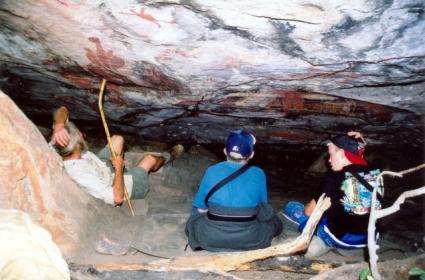 |
| |
European Cave Archaeology
Habitation of natural caves in southern Europe commenced during the Upper Paleolithic period, around 20,000 years ago and before the last Ice Age. Some rock carvings survive from this era. The images below come from France and Spain [7].
|
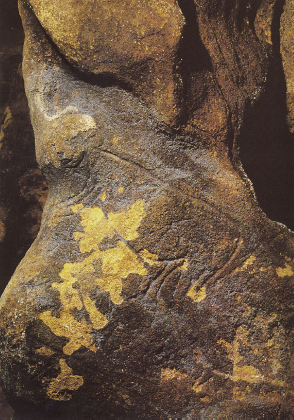 |
|
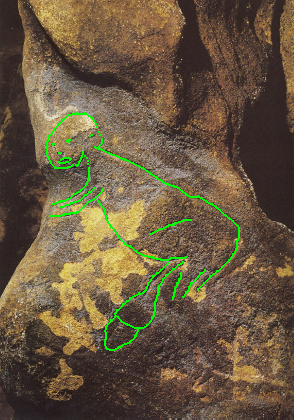 |
Rock carving in the cave of Saint-Cirq (Le Bugue, France), depicting a male with a disproportionately large penis
(to say the least!) and bared glans.
|
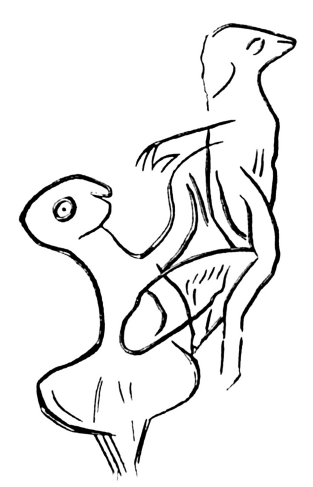 | | 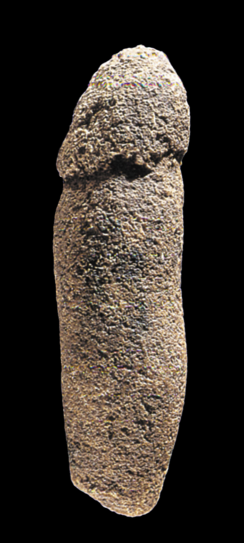 |
Engraving from Los Casares Cave, Spain, also about
20,000 years old, showing similarly exaggerated sexual
characteristics. | | Sculpted circumcised penis,
Castanet Cave, Spain |
All images are from Angulo et al.[7]. While the very stylized images of intercourse could possibly be taken as just showing retracted foreskins, the penis sculpture could only represent a circumcised organ. The authors suggest it might have been a dildo but it does look a bit rough for that! More likely it was just a fertility symbol. There are many examples from this time period of penises drawn, carved or painted with the glans bare, but none so far discovered depict the operation of circumcision.
Egypt at the time of the Pharaohs
The best-known Egyptian depiction of circumcision is to be found in the “The Physician’s Tomb”, built for Ankhmabor at Saqqara. (
Image courtesy of the Wellcome Library)
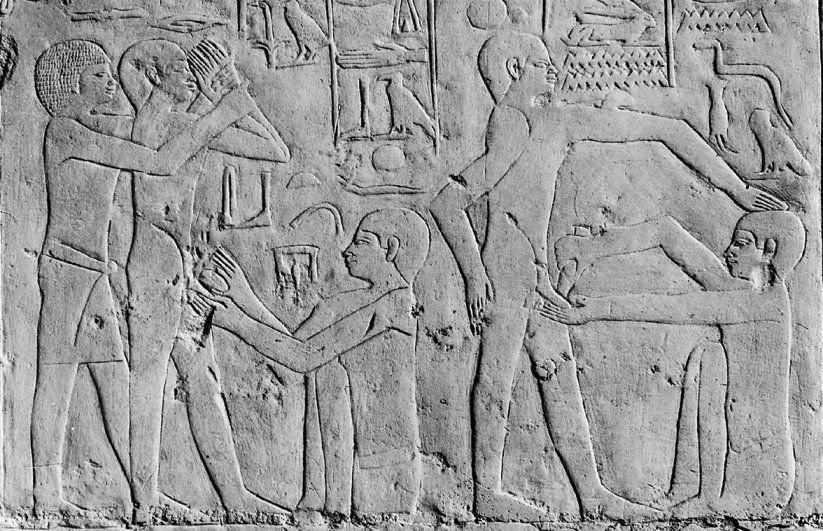
This scene dates from between 2,500 - 3,000 BC. Much hot air has been vented on the age at which boys were circumcised in ancient Egypt and the proportion of the male population that was circumcised. Here we see two boys - the taller one on the right steadies himself with one hand on his hip, the other on the circumciser's head. The shorter one on the left is held by someone his own age (probably the next in line for the operation). The squatting circumcisers, when standing up, would be at least a head taller than either boy, so the boys must be between 9 and 11 in age. This fits with other evidence. The Nicholson Museum in Sydney has a mummy of a boy aged around 6-7, and X-ray images show that he was not circumcised [3]. On the other hand, the statuette of a just pubertal teenager, Meryrahashtef (in our Art page.) shows clearly that he was circumcised.
The idea that not all Egyptians were circumcised seems to be based on X-ray imaging of the mummy of the pharaoh Ahomse (C16 BC) but this is an exception. In a stele a man called Uha describes his circumcision in a mass ceremony of 120 boys in the 23rd century BC [5]. This hardly seems to make it a minority practice. (He proudly boasts that all took it stoically without struggling or crying out).
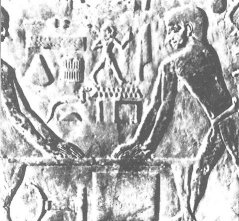 | | This rather poor-quality image, also from the Saqqara site, shows probably the world's first documented wardrobe malfunction. A carpenter is at work, his loin-cloth has slipped, and he is revealed to be both well-endowed and circumcised [5]. This hardly suggests that circumcision was just for the elite. In fact Egyptian art, while not embracing nudity in the Greek style, always shows nude men as circumcised if it shows them at all. (See below, in the Art section).
|
Israel
Very little archaeological evidence is available about Israeli circumcision. The ivory engraving (above) shows one of the few pieces of pictorial evidence. This is at least partly because Jewish people were, and are, very prudish about nudity. Not that this would seem strange to a Hindu or Muslim, but it does seem strange to a European (or African, or Australian).
The biblical account of Abraham's circumcision has been comprehensively analysed at aboutcirc so there is no need to go into it here. The key issues seem to be that Abraham suffered from phimosis and therefore had difficulty in fathering offspring, and that the ages of those involved are obviously wrong by about a factor of two.
This little phallic sculpture was excavated in Israel in 2013. In spite of press suggestions to the contrary it is obviously too small to be a dildo, and in any case anyone wanting a dildo back then would certainly buy one of wood, not stone! The interesting point is that it is about 6,000 years old, and so (arguably) precedes Abraham's covenant. In other words, is shows that circumcision was already commonplace among other inhabitants of the Holy Land before Abraham's covenant.
|
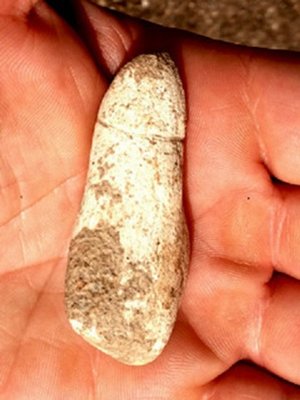
|
The Americas
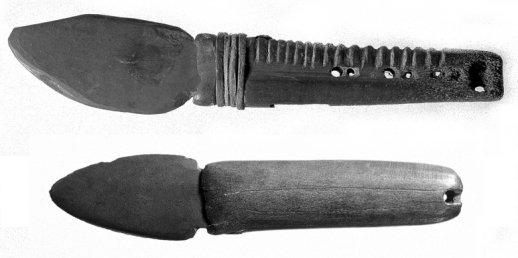
The original Americans entered from Alaska, via the Bering Strait. They brought circumcision with them as evidenced by these Inuit stone circumcision knives, but further details of Inuit circumcision are hard to find.
Images courtesy of the Wellcome Library
Nor do we know much of the circumcision customs of the many Native American nations that are now part of the USA, though it is clear that some did circumcise and others did not.
When the Spanish and Portuguese conquistadores arrived in the Americas in the mid 16th century there were three great civilizations present, the Aztecs in southern North America, the Maya in Central America, and the Incas in South America. All practised circumcision. The jungle tribes, such as the inhabitants of the Amazon basin, did not. Again, this probably represents cultural loss in adapting to difficult conditions (one tribe even lost the ability to count beyond 3).
The first civilization the Spaniards encountered were the Mayas. They were an old-established civilization and had rather interesting rules about sex - essentially that intercourse should only occur in matrimony. However, they realized that adolescent boys needed sexual outlets, and hence adolescent homosexuality was not just encouraged, it was compulsory. (This may seem awfully familiar to anyone who attended an English Public School). Adult homosexuality was freely tolerated. It all seems pretty modern and the Maya civilization seems to have been a very harmonious society. But it horrified the Spaniards!
As a result the Spaniards regarded all native Americans as sodomites, even though in both the Inca and Aztec empires sodomy was strictly forbidden and attracted the death sentence. (The Incas seemed to use accusations of sodomy to punish political opponents - shades of 21st century Malaysia). The conquistadores wanted to use this imagined pretext to eliminate the native populations, but the Pope was not having that, and insisted that they should all be converted to Christianity. This meant abandoning circumcision. It also, tragically, meant systematic destruction of their reconds and relics.
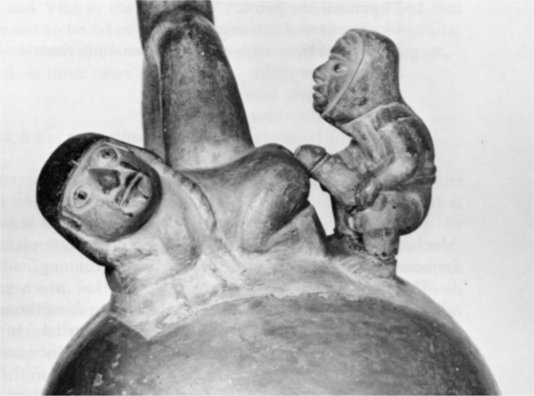
The Incas were a relatively young civilization, and their predecessors, the Moche, seem to have had much more liberal views about sex. A large number of their drinking vessels have come down to us, preserved as grave goods. Many are decorated with highly erotic sculptures. Often one has to drink from a penis - circumcised, of course (below).
The illustration shows the decoration of one such cup, taken from Reay Tannahill's book Sex in History [8]. She quotes an 'eminent authority', Dr Francisco Guerra, who has analysed the images, and come up with the startling finding that 31% show heterosexual anal intercourse while only 11% show conventional heterosexual intercourse. (For comparison, 14% show oral sex, 2% show male homosexuality and 1% lesbianism).
One can, I suppose, imagine the learned Dr. Guerra being unable to think of sex other than in the missionary position, but it's surprising to find the broad-minded Reay Tannahill falling for it. Yet she does, and goes into wild speculation about why the Moche may have turned to anal sex. It is quite obvious that what these images show is conventional penis in vagina sex in the 'doggy' position. The Moche never encountered missionaries! Why the missionaries cared what position people had sex in is a mystery (and so is how they knew about it) but the fact is that it wouldn't be called the missionary position if the missionaries hadn't found that most of their converts didn't favour it. In the case of the Moche, it seems they used two positions but doggy style was 3 to 1 favourite.
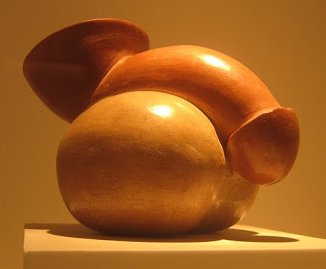 | These penises are definitely circumcised, not just denuded in erection, since even flaccid ones (which are quite common) are shown tightly circumcised, as we see here.
This image, and the one below, come from the Museo Larco in Lima, Peru, which has a large collection of these pots, and are reproduced courtesy of Jack and Jill Travel. |
This pot, which you have to fellate to drink from, clearly shows the circumcision scar - low and tight. Note the ring of holes aroung the top so that drinking from there is not an option! All the surviving intact pots come from graves, but broken ones from house sites show that they were also in domestic use.
You can see more of these pots at Jack and Jill Travel . |
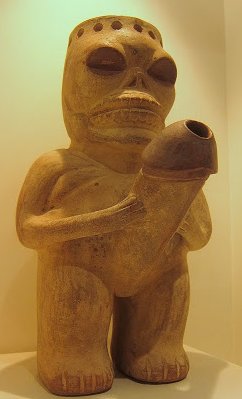 |
Acknowledgements
Thanks to Tom, Eric and Alex, Artsy magazine, the British Museum and the Tate Gallery for images and links and to the Royal Academy, the Art Gallery of NSW and Wikipedia for information.
References
1. Wikipedia, Early Human Migrations
2. Göran Burenhult: Die ersten Menschen, Weltbild Verlag, 2000. ISBN 3-8289-0741-5 via Wikipedia
3. Guy Cox & Brian J. Morris, 2012. Why Circumcision: From Prehistory to the Twenty-First Century. Chapter 21 in: D.A. Bolnick et al. (eds.), Surgical Guide to Circumcision, Springer-Verlag London. 243-259
4. Bryk F. Circumcision in Man and Woman. (tr. Felix Berger). New York: American Ethnological Press, 1934: 342 pp. (Facsimile reprint New York: AMS Press, 1974).
5. Larue GA. Religious Traditions and Circumcision. Second International Symposium on Circumcision, San Francisco, California, April 30-May 3, 1991. First published in The Truthseeker, July/August 1989, 4-8.
6. Scheer, R. Aborigine Rock Paintings Illustrate Secret Ceremonies, published in Travel Writers Tales. [Accessed 10.Apr.2011]
7. Angulo, JC and García-Díez, M. Male Genital Representation in Paleolithic Art : Erection and Circumcision Before History : Urology 74: 10–14, 2009.
8. Reay Tannahill, Sex in History. Hamish Hamilton, London, 1980 480pp
Copyright © 1992 - 2017, All Rights Reserved CIRCLIST.















